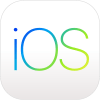Apple A8X
 Apple A8X chip | |
| Produced | From October 16, 2014 to Present |
|---|---|
| Designed by | Apple Inc. |
| Common manufacturer(s) | |
| Max. CPU clock rate | 1.5[2] GHz |
| Min. feature size | 20 nm[1] |
| Instruction set | A64, A32, T32 |
| Microarchitecture | Typhoon[3] ARMv8-A-compatible |
| Product code | APL1012[4] |
| Cores | 3[2] |
| L1 cache | Per core: 64 KB instruction + 64 KB data[2] |
| L2 cache | 2 MB shared[2] |
| L3 cache | 4 MB[5] |
| Predecessor | Apple A7 |
| Successor | Apple A9X |
| GPU | PowerVR Series 6XT GXA6850 (octa-core)[5][6] |
| Application | Mobile |
| Variant | Apple A8 |
The Apple A8X is a 64-bit system on a chip (SoC) designed by Apple Inc. and manufactured by TSMC.[1] It first appeared in the iPad Air 2, which was announced on October 16, 2014.[7] It is a variant of the A8 inside the iPhone 6 family cellphones and Apple states that it has 40% more CPU performance and 2.5 times the graphics performance of its predecessor, the Apple A7.[7][8]
Design
The A8X has three cores clocked at 1.5 GHz, a more powerful GPU compared to the A8 and it contains 3 billion transistors.[8] With an extra 100 MHz and an additional core, the A8X performs around 13% better on single threaded and 55% better on multithreaded operations than the A8 inside the iPhone 6 and iPhone 6 Plus.[2]
Further comparison to the A8 shows that the A8X uses a metal heat spreader, which the A8 does not, and it doesn't use the package on package configuration with included RAM which the A8 does. This is similar to how the older "X" variants, the A5X and A6X, were designed.[9] Instead the A8X in the iPad Air 2 uses an external 2 GB RAM module.[2][9]
In a first for Apple, the A8X is reported to have a semi-custom GPU. The A8X uses an 8-cluster GPU based on Imagination Technologies PowerVR Series 6XT architecture. Officially, the largest implementation of Rogue is a 6-cluster design, indicating that Apple has made customizations to the design in order to provide higher performance. This GPU is referred to as the GXA6850, with the "A" denoting the Apple customization.[10]
Products that include the Apple A8X
See also
- Apple mobile application processors, the range of ARM-based mobile processors designed by Apple for their consumer electronic devices.
- Comparison of ARMv8-A cores
References
- 1 2 3 TSMC reportedly lands CPU orders for Apple next-generation iPad
- 1 2 3 4 5 6 iPad Air 2 Benchmark Points to A8X Chip With Triple-Core 1.5 GHz CPU, 2 GB RAM
- ↑ The Samsung Exynos 7420 Deep Dive - Inside A Modern 14nm SoC
- ↑ "iPad Air 2 Teardown". iFixit. October 22, 2014. Retrieved October 22, 2014.
- 1 2 "Apple A8X's GPU - GXA6850, Even Better Than I Thought". Anandtech. November 11, 2014. Retrieved November 12, 2014.
- ↑ "Imagination PowerVR GXA6850 - NotebookCheck.net Tech". NotebookCheck.net. November 26, 2014. Retrieved November 26, 2014.
- 1 2 "Apple Introduces iPad Air 2—The Thinnest, Most Powerful iPad Ever" (Press release). Apple. October 16, 2014. Retrieved October 16, 2014.
- 1 2 "iPad Air 2 - Performance". Apple. October 16, 2014. Retrieved October 16, 2014.
- 1 2 Latest iPad Air 2 component leak shows A8X chip & 2GB RAM
- ↑ "A8X's GPU - Even Better Than I Thought". Anandtech. November 11, 2014. Retrieved September 3, 2015.
